The Potential for Water Banking in Australia’s Murray–Darling Basin to Increase Drought Resilience
Abstract
1. Introduction
2. Materials and Methods
2.1. Murray–Darling Basin Overview
2.2. Regional Aquifer Storage Potential Assessment
2.3. Sub-Catchment Recharge Simulation
3. Results and Discussion
3.1. Regional Aquifer Storage Potential
3.2. Sub-Catchment Recharge Simulation
4. Conclusions
Author Contributions
Funding
Acknowledgments
Conflicts of Interest
References
- Dillon, P.J. Australian progress in managed aquifer recharge and the water banking frontier. J. Aus. Water Assoc. 2015, 42, 53–57. [Google Scholar]
- Megdal, S.B.; Dillon, P.; Seasholes, K. Water Banks: Using Managed Aquifer Recharge to Meet Water Policy Objectives. Water 2014, 6, 1500–1514. [Google Scholar] [CrossRef]
- Craig, I.; Green, A.; Scobie, M.; Schmidt, E. Controlling Evaporation Loss from Water Storages; Publication University of Southern Queensland: Toowoomba, Australia, 2005. [Google Scholar]
- Helfer, F.; Lemckert, C.; Zhang, H. Impacts of climate change on temperature and evaporation from a large reservoir in Australia. J. Hydrol. 2012, 475, 365–378. [Google Scholar] [CrossRef]
- Scanlon, B.R.; Faunt, C.C.; Longuevergne, L.; Reedy, R.C.; Alley, W.M.; McGuire, V.L.; McMahon, P.B. Groundwater depletion and sustainability of irrigation in the US High Plains and Central Valley. Proc. Natl. Acad. Sci. USA 2012, 109, 9320–9325. [Google Scholar] [CrossRef]
- Scanlon, B.R.; Reedy, R.C.; Faunt, C.C.; Pool, D.; Uhlman, K. Enhancing drought resilience with conjunctive use and managed aquifer recharge in California and Arizona. Environ. Res. Lett. 2016, 11, 035013. [Google Scholar] [CrossRef]
- Megdal, S.B.; Dillon, P. Policy and Economics of Managed Aquifer Recharge and Water Banking. Water 2015, 7, 592–598. [Google Scholar] [CrossRef]
- Megdal, S. Arizona Groundwater Management. Ph.D. Thesis, University of Arizona, Tucson, AZ, USA, 15 October 2012. [Google Scholar]
- Dillon, P.; Stuyfzand, P.; Grischek, T.; Lluria, M.; Pyne, R.D.G.; Jain, R.C.; Bear, J.; Schwarz, J.; Wang, W.; Fernandez, E.; et al. Sixty years of global progress in managed aquifer recharge. Hydrogeol. J. 2018, 27, 1–30. [Google Scholar] [CrossRef]
- Gao, L.; Connor, J.D.; Dillon, P. The Economics of Groundwater Replenishment for Reliable Urban Water Supply. Water 2014, 6, 1662–1670. [Google Scholar] [CrossRef]
- Khan, S.J.; Anderson, R. Potable reuse: Experiences in Australia. Curr. Opin. Environ. Sci. Health 2018, 2, 55–60. [Google Scholar] [CrossRef]
- ABARES. Irrigated farms in the Murray-Darling Basin Australian Government Department of Agriculture, Water and the Environment, Australia. Available online: https://www.agriculture.gov.au/abares/research-topics/surveys/irrigation (accessed on 11 September 2020).
- Heberger, M. Australia’s Millennium Drought: Impacts and Responses; Island Press: Washington, DC, USA, 2012; pp. 97–125. [Google Scholar]
- CSIRO. Water availability in the Murray-Darling Basin. In A Report to the Australian Government from the CSIRO Murray-Darling Basin Sustainable Yields Project; Commonwealth Scientific and Industrial Research Organisation (CSIRO): CSIRO, Canberra, Australia, 2008; p. 67. [Google Scholar]
- ANZECC-ARMCANZ. Australian and New Zealand Guidelines for Fresh and Marine Water Quality; Australian New Zealand Environment Conservation Council Agriculture Resource Management Council of Australia New Zealand: Canberra, Australia, 2000.
- Ward, J.D.; Simmons, C.T.; Dillon, P.; Pavelic, P. Integrated assessment of lateral flow, density effects and dispersion in aquifer storage and recovery. J. Hydrol. 2009, 370, 83–99. [Google Scholar] [CrossRef]
- Gonzalez, D.; Page, D.; Vanderzalm, J.; Dillon, P. Setting Water Quality Trigger Levels for the Operation and Management of a MAR System in Parafield, South Australia. J. Hydrol. Eng. 2015, 20, B5014001. [Google Scholar] [CrossRef]
- Clark, R.; Gonzalez, D.; Dillon, P.; Charles, S.; Cresswell, D.; Naumann, B. Reliability of water supply from stormwater harvesting and managed aquifer recharge with a brackish aquifer in an urbanising catchment and changing climate. Environ. Model. Softw. 2015, 72, 117–125. [Google Scholar] [CrossRef]
- Rodríguez-Escales, P.; Canelles, A.; Sanchez-Vila, X.; Folch, A.; Kurtzman, D.; Rossetto, R.; Escalante, E.F.; Lobo-Ferreira, J.-P.; Sapiano, M.; San-Sebastián, J.; et al. A risk assessment methodology to evaluate the risk failure of managed aquifer recharge in the Mediterranean Basin. Hydrol. Earth Syst. Sci. 2018, 22, 3213–3227. [Google Scholar] [CrossRef]
- American Society of Civil Engineers. Standard Guidelines for Managed Aquifer Recharge. ASCE/EWRI 69-19. Am. Soc. Civil Eng. 2020, 127–130. [Google Scholar] [CrossRef]
- NRMMC-EPHC-NHMRC. Australian Guidelines for Water Recycling, Managing Health and Environmental Risks; Natural Resource Management Ministerial Council, Environment Protection and Heritage Council National Health and Medical Research Council: Canberra, Australia, 2009; p. 237.
- Dillon, P.; Pavelic, P.; Page, D.; Beringen, H.; Ward, J. Managed Aquifer Recharge: An Introduction; National Water Commission: Canberra, Australia, 2009; p. 65. [Google Scholar]
- Ross, A.; Hasnain, S. Factors affecting the cost of managed aquifer recharge (MAR) schemes. Sustain. Water Resour. Manag. 2018, 4, 179–190. [Google Scholar] [CrossRef]
- Dillon, P. Managing Aquifer Recharge in Integrated Solutions to Groundwater Challenges; Informa UK Limited: Sheepen, UK, 2016; pp. 3–16. [Google Scholar]
- ABS. Water and the Murray–Darling Basin—A Statistical Profile, 2000–2001 to 2005–2006; Australian Bureau of Statistics: Canberra, Australia, 2008. [Google Scholar]
- BOM. National Water Account 2019. Available online: http://www.bom.gov.au/water/nwa/2019/mdb/index.shtml (accessed on 30 September 2020).
- Potter, N.; Chiew, F.H.S.; Frost, A. An assessment of the severity of recent reductions in rainfall and runoff in the Murray–Darling Basin. J. Hydrol. 2010, 381, 52–64. [Google Scholar] [CrossRef]
- MDBA. Discover the Basin—Landscape. Murray-Darling Basin Authority. Available online: https://www.mdba.gov.au/discover-basin/landscape (accessed on 11 September 2020).
- Barron, O.V.; Crosbie, R.S.; Charles, S.P.; Dawes, W.R.; Ali, R.; Evans, W.R.; Cresswell, R.; Pollock, D.; Hodgson, G.; Currie, D.; et al. Climate Change Impact on Groundwater Resources in Australia; Waterlines Report Series; National Water Commission: Turner, Australia, 2011. [Google Scholar]
- Crosbie, R.S.; McCallum, J.L.; Walker, G.R.; Chiew, F.H.S. Episodic recharge and climate change in the Murray-Darling Basin, Australia. Hydrogeol. J. 2011, 20, 245–261. [Google Scholar] [CrossRef]
- MDBA. Statement of Expectations for Managing Groundwater. In Groundwater Management in the Murray–Darling Basin; Murray-Darling Basin Authority: Canberra, Australia, 2019. [Google Scholar]
- Ife, D.; Skelt, K. Murray-Darling Basin Groundwater Status 1990–2000: Summary Report; Murray-Darling Basin Commission: Canberra, Australia, 2004.
- Leblanc, M.; Tweed, S.; Van Dijk, A.; Timbal, B. A review of historic and future hydrological changes in the Murray-Darling Basin. Glob. Planet. Chang. 2012, 80, 226–246. [Google Scholar] [CrossRef]
- DAWE. Environmental Water Holdings. Department of Agriculture, Water and Environment, Australian Government. Available online: http://www.environment.gov.au/water/cewo/about/water-holdings (accessed on 30 September 2020).
- MDBA. Water Markets and Trade. Murray–Darling Basin Authority. Australian Government. Available online: https://www.mdba.gov.au/managing-water/water-markets-and-trade (accessed on 11 September 2020).
- Grafton, Q.; Colloff, M.; Marshall, V.; Williams, J. Confronting a post-truth water world in the Murray-Darling Basin, Australia. Water Altern. 2020, 13, 1–28. [Google Scholar]
- Malczewski, J. GIS and Multicriteria Decision Analysis; John Wiley & Sons: New York, NY, USA, 1999. [Google Scholar]
- Gallant, J.; Wilson, N.; Dowling, T.; Read, A.; Inskeep, C. SRTM-Derived 1 Second Digital Elevation Models Version 1.0; Geoscience Australia: Canberra, Australia, 2011.
- Grundy, M.J.; Rossel, R.A.V.; Searle, R.D.; Wilson, P.L.; Chen, C.; Gregory, L. Soil and Landscape Grid of Australia. Soil Res. 2015, 53, 835–844. [Google Scholar] [CrossRef]
- Raymond, O.L.; Liu, S.; Gallagher, R.; Zhang, W.; Highet, L.M. Surface Geology of Australia 1:1 Million Scale Dataset; Geoscience Australia: Canberra, Australia, 2012.
- Wilford, J.; Searle, R.; Thomas, M.; Grundy, M. Soil and Landscape Grid National Soil Attribute Maps-Depth of Regolith (3’’ resolution)—Release 2. v6. CSIRO Data Collect. 2015. Available online: https://data.csiro.au/collections/collection/CIcsiro:11393v6 (accessed on 13 October 2020). [CrossRef]
- MDBC. Hydrogeology of the Murray Basin (1:250,000); Murray Darling Basin Commission: Canberra, Australia, 2000.
- Valverde, J.P.B.; Blank, C.; Roidt, M.; Schneider, L.; Stefan, C. Application of a GIS Multi-Criteria Decision Analysis for the Identification of Intrinsic Suitable Sites in Costa Rica for the Application of Managed Aquifer Recharge (MAR) through Spreading Methods. Water 2016, 8, 391. [Google Scholar] [CrossRef]
- Zaidi, F.K.; Nazzal, Y.; Ahmed, I.; Naeem, M.; Jafri, M.K. Identification of potential artificial groundwater recharge zones in Northwestern Saudi Arabia using GIS and Boolean logic. J. Afr. Earth Sci. 2015, 111, 156–169. [Google Scholar] [CrossRef]
- Heath, R.C. Basic Ground-Water Hydrology; US Department of the Interior: Washington, DC, USA, 1998; Volume 2220.
- Dillon, P.; Arshad, M. Managed Aquifer Recharge. In Integrated Groundwater Management; Jakeman, A.J., Barreteau, O., Hunt, R.J., Rinaudo, J.D., Ross, A., Eds.; Springer: Cham, Switzerland, 2016; Chapter 17; pp. 435–452. [Google Scholar] [CrossRef]
- Alakayleh, Z.; Clement, T.P.; Fang, X. Understanding the Changes in Hydraulic Conductivity Values of Coarse- and Fine-Grained Porous Media Mixtures. Water 2018, 10, 313. [Google Scholar] [CrossRef]
- Morris, D.; Johnson, A. Summary of Hydrologic and Physical Properties of Rock and Soil Materials, as Analyzed by the Hydrologic Laboratory of the U.S. Geological Survey, 1948–1960; US Geological Survey: Washington, DC, USA, 1967.
- BOM. Australian Hydrological Geospatial Fabric; Australian Bureau of Meteorology: Canberra, Australia, 2012.
- ACLUMP. Catchment Scale Land Use of Australia—Update December 2018. In Australian Collaborative Land Use and Management Program (ACLUMP); Australian Government Department of Agriculture: Canberra, Australia, 2018. [Google Scholar]
- ATO. Consumer Price Index (CPI) Rates. Available online: https://www.ato.gov.au/Rates/Consumer-price-index/ (accessed on 11 September 2020).
- CSIRO; SKM. Report Cards for Groundwater Sustainable Diversion Limit Areas for the Murray-Darling Basin Plan; CSIRO, Water for a Healthy Country National Research Flagship: Canberra, Australia, 2010; p. 95. [Google Scholar]
- Hope, M. Greater Macquarie Catchment Irrigation Profile; NSW Agriculture: New South Wales, Australia, 2003.
- NSW-DPI. Salinity Tolerance in Irrigated Crops; NSW Department of Primary Industries: New South Wales, Australia, 2017.
- BOM. National Groundwater Information System; Australian Bureau of Meteorology: Canberra, Australia, 2020.
- CSIRO; SKM. Sustainable Extraction Limits Derived from the Recharge Risk Assessment Method—South Australia; CSIRO, Water for a Healthy Country National Research Flagship: Canberra, Australia, 2010; p. 51. [Google Scholar]
- DEW. Angas Bremer PWA Murray Group Limestone Aquifer 2018 Groundwater Level and Salinity Status Report; Government of South Australia, Department for Environment and Water: Adelaide, Australia, 2019.
- DEW. Water Allocation Plan, Eastern Mount Lofty Ranges; South Australian Murray-Darling Basin Natural Resources Management Board; Department for Environment and Water (DEW), Government of South Australia: Adelaide, Australia, 2019.
- Lawrie, K.C.; Brodie, R.S.; Tan, K.P.; Somerville, P.; Gibson, D.; Magee, J.; Clarke, J.D.A.; Gow, L.; Halas, L.; Apps, H.E.; et al. BHMAR Project: Assessment of Potential Groundwater Resources and Underground Storage Options in the Darling Floodplain; Geoscience Australia: Canberra, Australia, 2012; p. 876.
- NSW-DPI. Water Management Fact Sheet. In Measurement and Comparison of Evaporation in Water Storages; NSW Department of Primary Industries: New South Wales, Australia, 2019. [Google Scholar]
- Fuentes, I.; Vervoort, R.W. Site suitability and water availability for a managed aquifer recharge project in the Namoi basin, Australia. J. Hydrol. Reg. Stud. 2020, 27, 100657. [Google Scholar] [CrossRef]
- Martin, R.; Whittington, H.; Young, W.; Lush, A. Managed aquifer recharge to support environmental outcomes on the Katarapko Floodplain. In Proceedings of the 10th International Symposium on Managed Aquifer Recharge, Madrid, Spain, 20–24 May 2019. [Google Scholar]
- Gupta, M.; Westwood, T.; Legg, P. MDB Water Market Dataset; Australian Bureau of Agricultural and Resource Economics and Sciences: Canberra, Australia, 2020. [CrossRef]
- Dillon, P.J.; Liggett, J.A. An ephemeral stream-aquifer interaction model. Water Resour. Res. 1983, 19, 621–626. [Google Scholar] [CrossRef]
- DRC. Water Management and Supply. Dubbo Regional Council. Available online: https://www.dubbo.nsw.gov.au/Our-Region-and-Environment/Water--sewerage-and-drainage/water-management-supply (accessed on 11 September 2020).
- NSC. Water Supply Networks. Narromine Shire Council. Available online: https://www.narromine.nsw.gov.au/environment/water (accessed on 11 September 2020).
- Cai, W.; Purich, A.; Cowan, T.; Van Rensch, P.; Weller, E. Did Climate Change–Induced Rainfall Trends Contribute to the Australian Millennium Drought? J. Clim. 2014, 27, 3145–3168. [Google Scholar] [CrossRef]
- Ross, A. Easy to say, hard to do: Integrated surface water and groundwater management in the Murray–Darling Basin. Hydrol. Res. 2012, 14, 709–724. [Google Scholar] [CrossRef]
- McMahon, T.A.; Peel, M.; Lowe, L.; Srikanthan, R.; McVicar, T.R. Estimating actual, potential, reference crop and pan evaporation using standard meteorological data: A pragmatic synthesis. Hydrol. Earth Syst. Sci. 2013, 17, 1331–1363. [Google Scholar] [CrossRef]

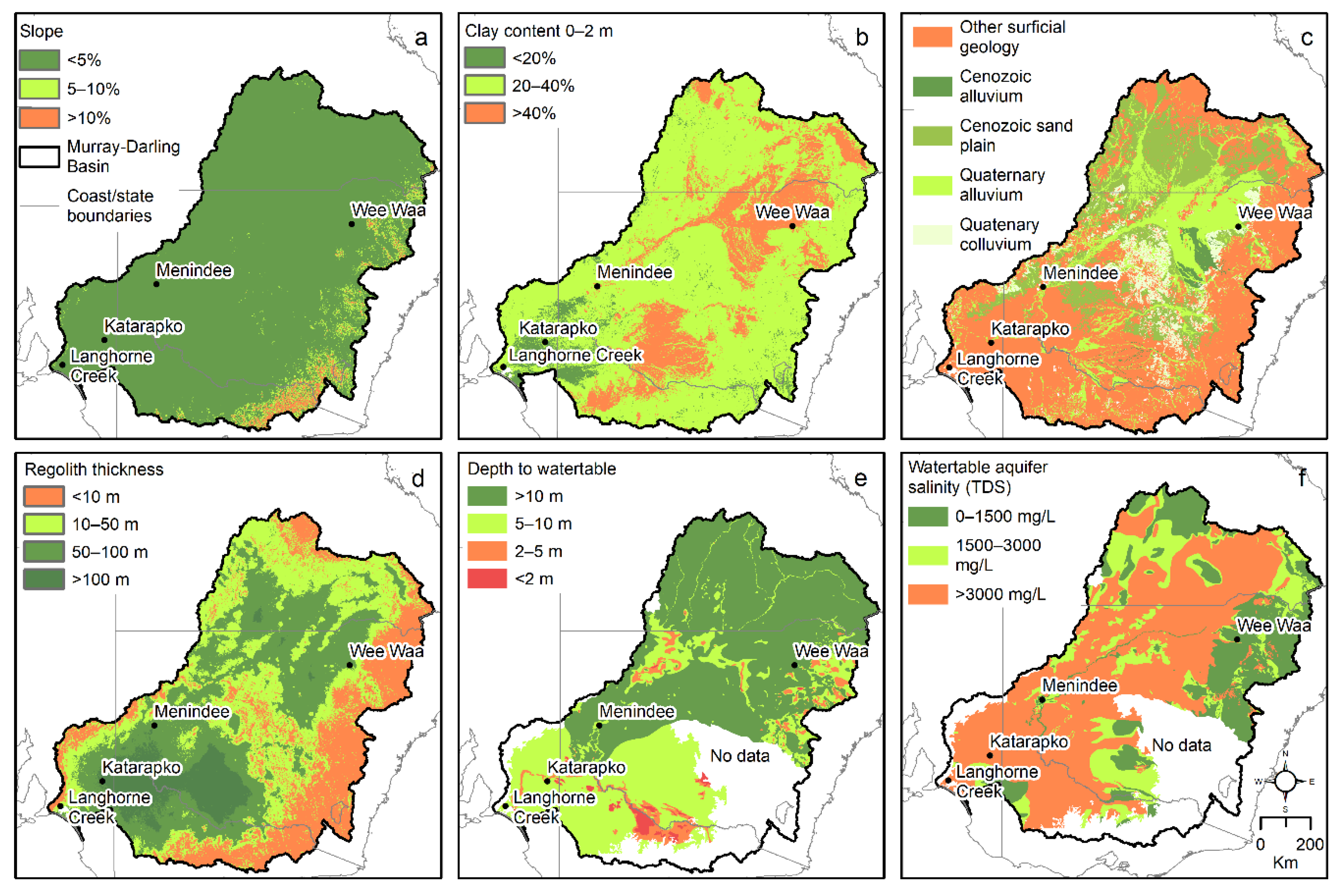

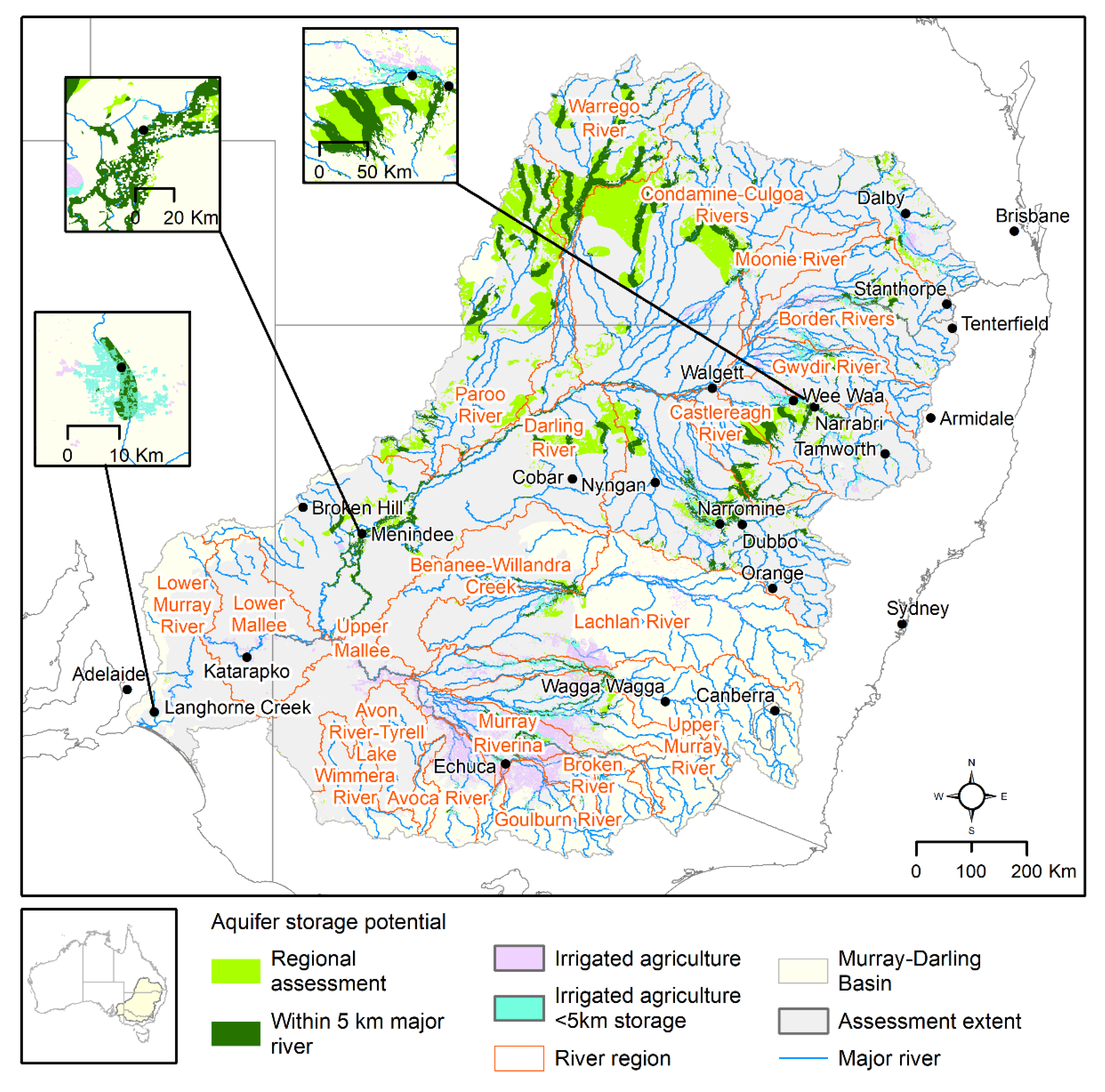
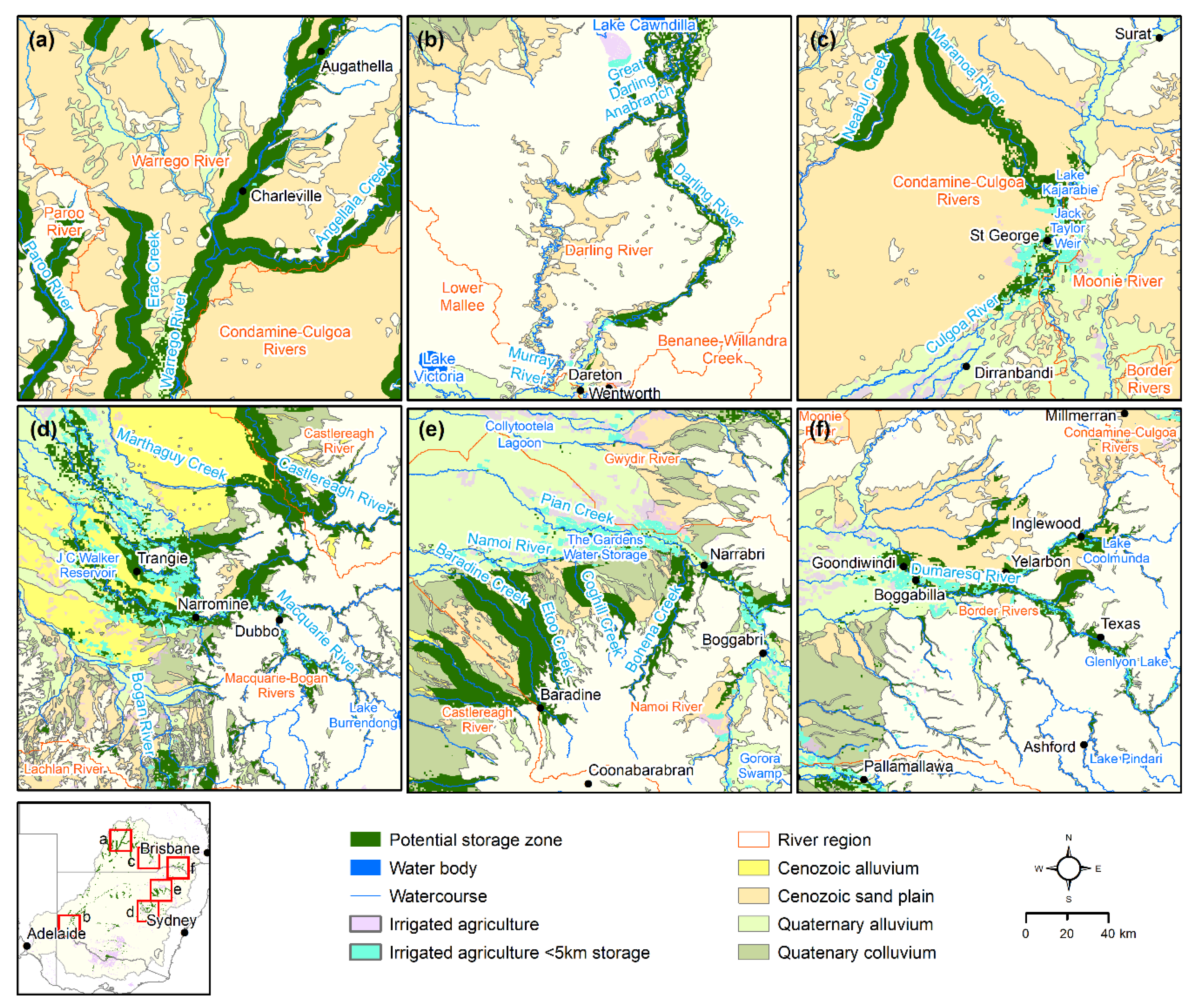
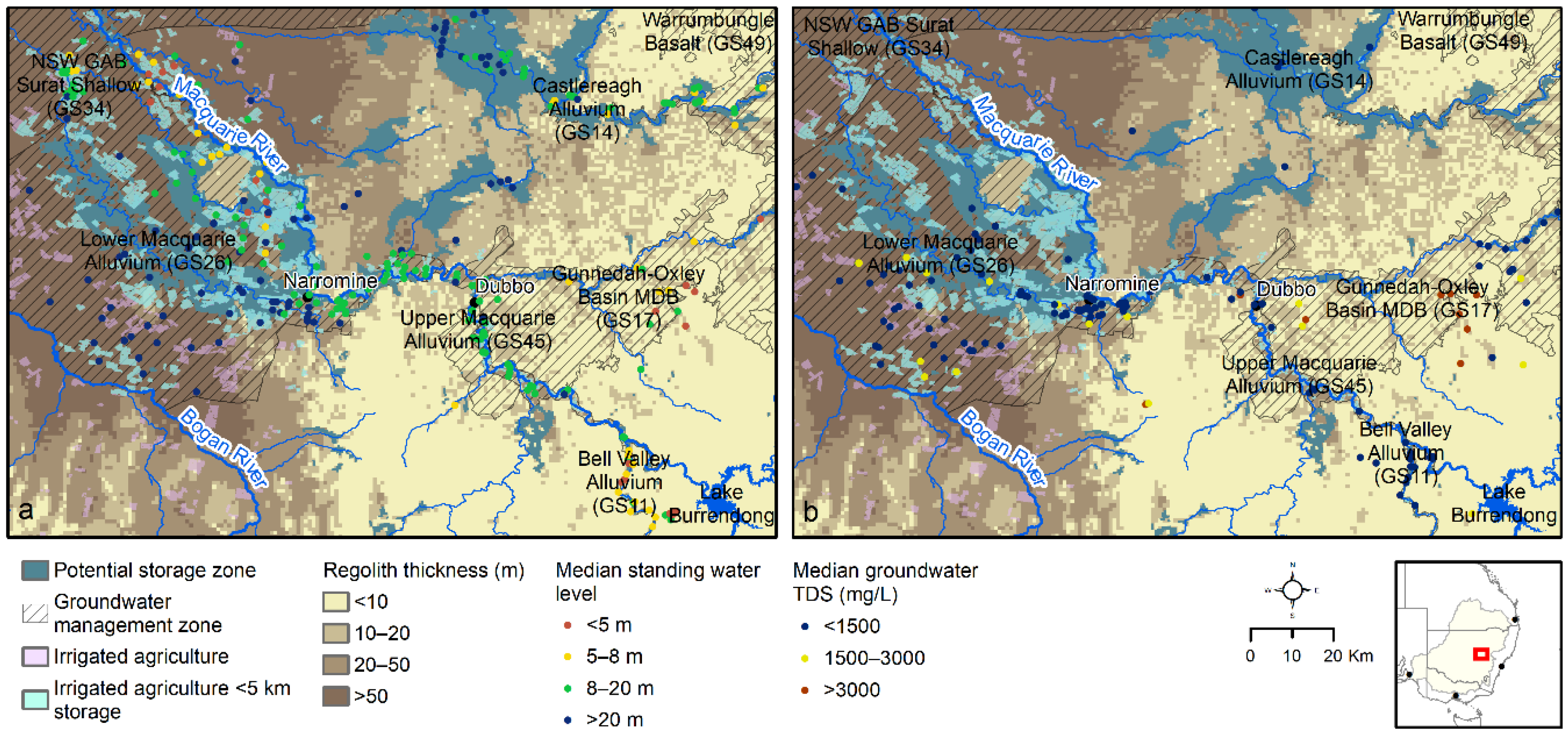
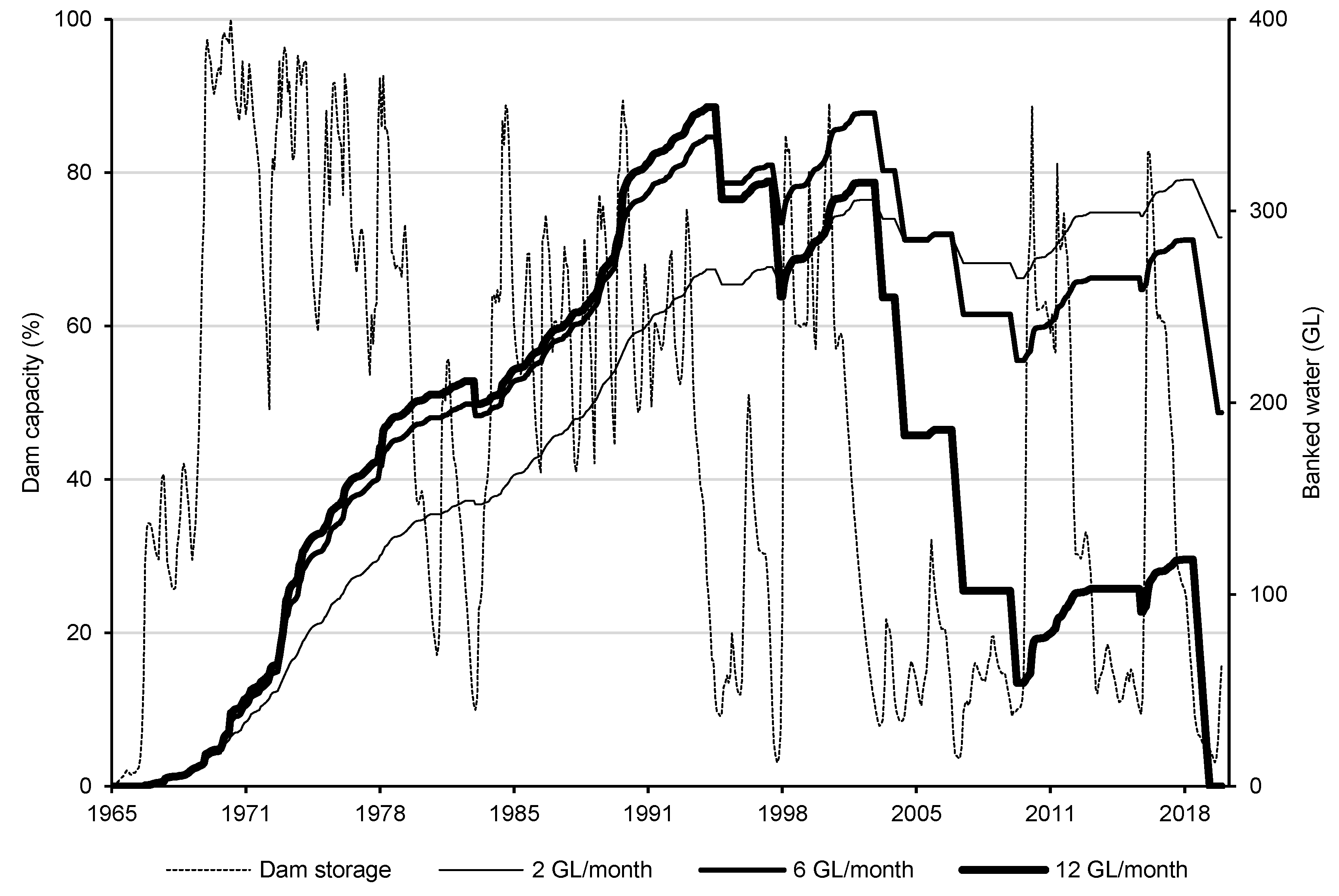

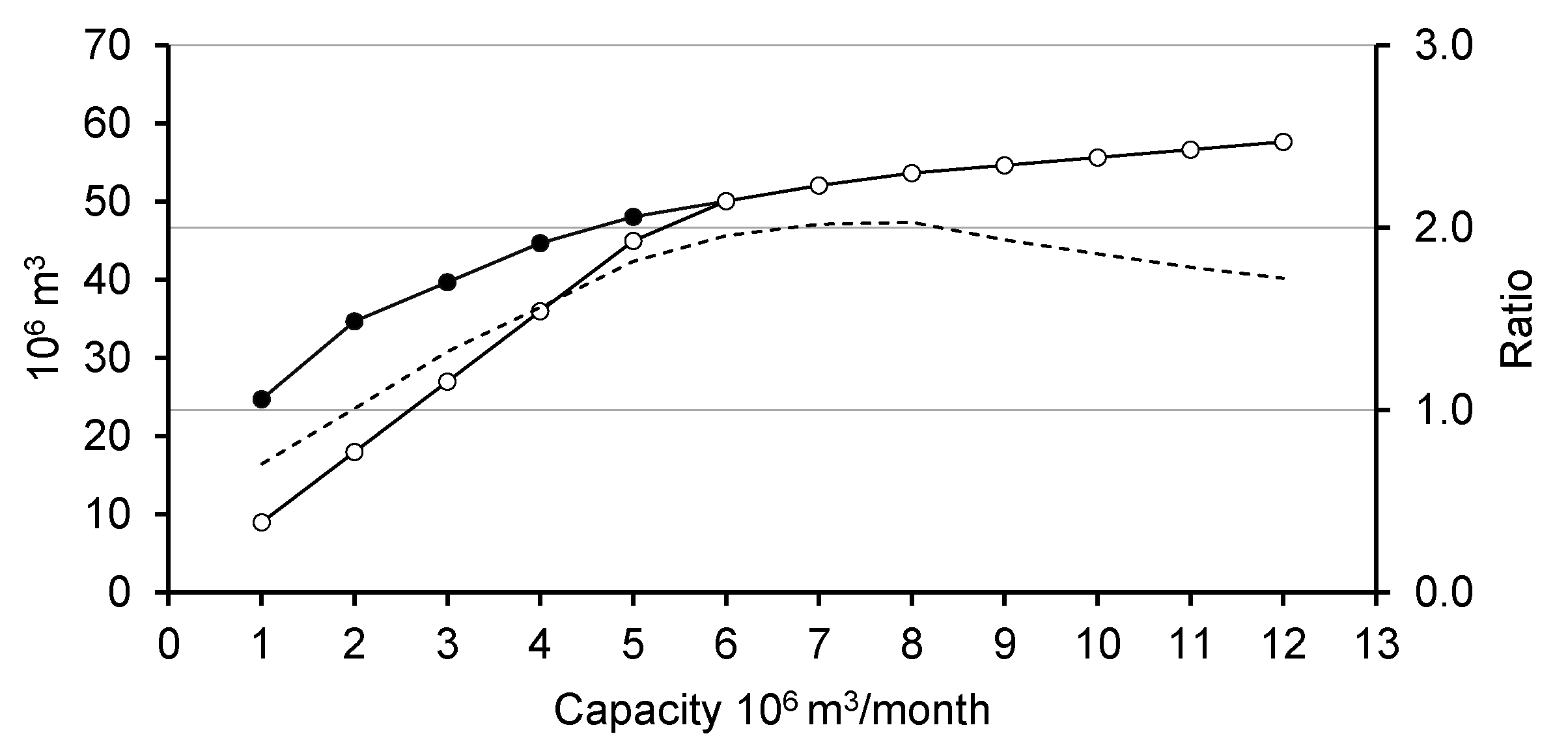
| Exclusion Criteria | Rationale | Data |
|---|---|---|
| Topographic slope > 10% | Low infiltration and/or retention potential on steep slopes | 1 arc-second (≈30 m) DEM [38] |
| Clay content > 40% | Permeability limited in soils with > 40% clay | Australian Soil Landscape Grid, 90 m resolution [39] |
| Geological formations consisted of highly consolidated or fine-grained material, or igneous or metamorphic rocks | Permeability limited in highly consolidated material | National surface geology map at 1:1 million scale [40] |
| Depth of regolith < 10 m | Storage limited in thin aquifers | National gridded median regolith thickness estimates, 90 m resolution [41] |
| Depth to water table < 5 m | Storage limited in shallow water table aquifers | Depth to water contours at 1:1 million scale for MDB water table aquifers [42] |
| Groundwater salinity (TDS) > 3000 mg/L | Recovered water quality must be fit for purpose | Groundwater salinity contours at 1:1 million scale for MDB water table aquifers [42] |
| Potential Volume (109 m3) Where Groundwater Salinity Was | ||||
|---|---|---|---|---|
| River Region † | <3000 mg/L | <1500 mg/L | Irrigated Area within 5 km of Potential Storage Zones (km2) * | Storage to Irrigated Area (m) * |
| Warrego River (a) | 0.69 | 0.26 | 7 | 97.61 |
| Castlereagh River | 0.18 | 0.18 | 9 | 19.62 |
| Darling River (b) | 0.51 | 0.27 | 148 | 3.47 |
| Condamine–Culgoa Rivers (c) | 0.65 | 0.19 | 1053 | 0.61 |
| Macquarie–Bogan Rivers (d) | 0.43 | 0.26 | 1142 | 0.37 |
| Benanee–Willandra Creek | 0.05 | 0.04 | 138 | 0.37 |
| Namoi River (e) | 0.27 | 0.27 | 1148 | 0.24 |
| Border Rivers (f) | 0.18 | 0.08 | 849 | 0.21 |
| Murray Riverina | 0.13 | 0.10 | 776 | 0.16 |
| Moonie River | 0.01 | 0.00 | 44 | 0.16 |
| Ovens River | 0.01 | 0.01 | 112 | 0.13 |
| Gwydir River | 0.06 | 0.05 | 508 | 0.12 |
| Lachlan River | 0.06 | 0.05 | 556 | 0.10 |
| Loddon River | 0.02 | 0.00 | 156 | 0.10 |
| Broken River | 0.01 | 0.00 | 62 | 0.08 |
| Billabong–Yanco Creeks | 0.08 | 0.00 | 984 | 0.08 |
| Lower Murray River | 0.01 | 0.00 | 84 | 0.08 |
| Goulburn River | 0.01 | 0.00 | 86 | 0.07 |
| Murrumbidgee River | 0.06 | 0.05 | 902 | 0.07 |
| Campaspe River | <0.01 | <0.01 | 98 | 0.02 |
| Cooper Creek–Bulloo River | <0.01 | <0.01 | 0 | |
| Paroo River | 0.60 | 0.06 | 0 | |
| Wimmera River | 0.00 | 0.00 | 0 | |
| Total | 3.99 | 1.89 | 8864 | 0.45 |
Publisher’s Note: MDPI stays neutral with regard to jurisdictional claims in published maps and institutional affiliations. |
© 2020 by the authors. Licensee MDPI, Basel, Switzerland. This article is an open access article distributed under the terms and conditions of the Creative Commons Attribution (CC BY) license (http://creativecommons.org/licenses/by/4.0/).
Share and Cite
Gonzalez, D.; Dillon, P.; Page, D.; Vanderzalm, J. The Potential for Water Banking in Australia’s Murray–Darling Basin to Increase Drought Resilience. Water 2020, 12, 2936. https://doi.org/10.3390/w12102936
Gonzalez D, Dillon P, Page D, Vanderzalm J. The Potential for Water Banking in Australia’s Murray–Darling Basin to Increase Drought Resilience. Water. 2020; 12(10):2936. https://doi.org/10.3390/w12102936
Chicago/Turabian StyleGonzalez, Dennis, Peter Dillon, Declan Page, and Joanne Vanderzalm. 2020. "The Potential for Water Banking in Australia’s Murray–Darling Basin to Increase Drought Resilience" Water 12, no. 10: 2936. https://doi.org/10.3390/w12102936
APA StyleGonzalez, D., Dillon, P., Page, D., & Vanderzalm, J. (2020). The Potential for Water Banking in Australia’s Murray–Darling Basin to Increase Drought Resilience. Water, 12(10), 2936. https://doi.org/10.3390/w12102936








